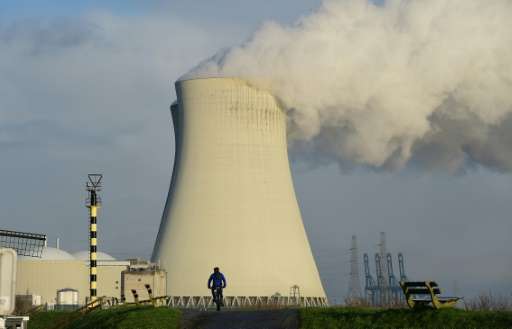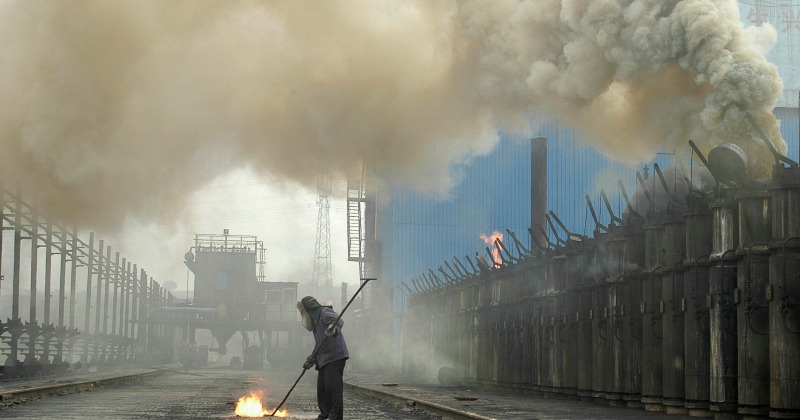

The alumina makes its way via an automated system to potrooms – three grey, long, low-lying buildings – where the manufacture of aluminium happens.

These silos house a mineral called alumina, the raw material used to produce aluminium. Data for carbon dioxide emissions include gases from the burning of fossil fuels and cement manufacture, but excludes emissions from land use such as deforestation.The two red-and-white silos of the aluminium smelter at Straumsvík are conspicuous from afar to everyone travelling from Iceland’s international airport to the capital city, Reykjavík. Cement manufacturing releases about half a metric ton of carbon dioxide for each metric ton of cement produced. In combustion different fossil fuels release different amounts of carbon dioxide for the same level of energy use: oil releases about 50 percent more carbon dioxide than natural gas, and coal releases about twice as much. Anthropogenic carbon dioxide emissions result primarily from fossil fuel combustion and cement manufacturing. Statistical Concept and Methodology: Carbon dioxide emissions, largely by-products of energy production and use, account for the largest share of greenhouse gases, which are associated with global warming. Estimates exclude fuels supplied to ships and aircraft in international transport because of the difficulty of apportioning the fuels among benefiting countries.
#Co2 emission in ethiopia series#
Trends estimated from a consistent time series tend to be more accurate than individual values.Įach year the CDIAC recalculates the entire time series since 1949, incorporating recent findings and corrections. Although estimates of global carbon dioxide emissions are probably accurate within 10 percent (as calculated from global average fuel chemistry and use), country estimates may have larger error bounds. Department of Interior's Geological Survey, USGS 2011). Department of Energy's Carbon Dioxide Information Analysis Center (CDIAC) calculates annual anthropogenic emissions from data on fossil fuel consumption (from the United Nations Statistics Division's World Energy Data Set) and world cement manufacturing (from the U.S. The Kyoto Protocol, an environmental agreement adopted in 1997 by many of the parties to the United Nations Framework Convention on Climate Change (UNFCCC), is working towards curbing CO2 emissions globally. Converting all other greenhouse gases (methane (CH4), nitrous oxide (N2O), hydrofluorocarbons (HFCs), perfluorocarbons (PFCs), sulphur hexafluoride (SF6)) to carbon dioxide (or CO2) equivalents makes it possible to compare them and to determine their individual and total contributions to global warming. Carbon dioxide (CO2) makes up the largest share of the greenhouse gases contributing to global warming and climate change. The environmental effects of carbon dioxide are of significant interest. The related terms - emission factor and carbon intensity - are often used interchangeably. Emission intensities are also used to compare the environmental impact of different fuels or activities. This is particularly important in agricultural economies.Įmission intensity is the average emission rate of a given pollutant from a given source relative to the intensity of a specific activity.

For a more complete idea of how a country influences climate change, gases such as methane and nitrous oxide should be taken into account.

The carbon dioxide emissions of a country are only an indicator of one greenhouse gas. Emissions of CO2 are from burning oil, coal and gas for energy use, burning wood and waste materials, and from industrial processes such as cement production. This is leading to an increase in the earth's surface temperature and to related effects on climate, sea level rise and world agriculture. The addition of man-made greenhouse gases to the Atmosphere disturbs the earth's radiative balance. It is also a major source of ocean acidification since it dissolves in water to form carbonic acid. It is the reference gas against which other greenhouse gases are measured, thus having a Global Warming Potential of 1.īurning of carbon-based fuels since the industrial revolution has rapidly increased concentrations of atmospheric carbon dioxide, increasing the rate of global warming and causing anthropogenic climate change. It is the principal anthropogenic greenhouse gas that affects the Earth's radiative balance. A byproduct of fossil fuel combustion and biomass burning, it is also emitted from land use changes and other industrial processes. Development Relevance: Carbon dioxide (CO2) is naturally occurring gas fixed by photosynthesis into organic matter.


 0 kommentar(er)
0 kommentar(er)
